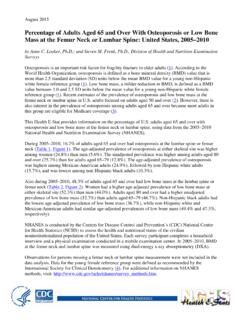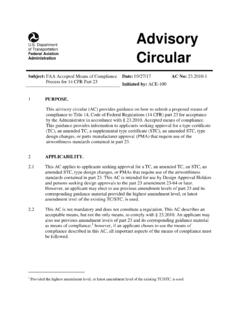Transcription of ANSI/ASHRAE/IES Standard 90.1-2010 Envelope
1 BUILDING ENERGY CODES UNIVERSITY 1 BUILDING ENERGY CODES UNIVERSITY ANSI/ASHRAE/IES Standard Envelope Edited & Presented by Donald Vigneau AIA Additional editing by Kevin Rose April 2011 PNNL-SA-80142 BUILDING ENERGY CODES UNIVERSITY 2 Mandatory Provisions (required for most compliance options) Building System Compliance Options Energy Code Compliance Prescriptive Option Energy Cost Budget Trade Off Option Simplified Envelope HVAC Lighting SWH Power Other Compliance Approaches BUILDING ENERGY CODES UNIVERSITY 3 Buildings Today Responsible for roughly 48% of our energy use and 70% of electricity consumption The scope of energy codes cover about 67% of a building s energy use The average consumer spends $2,175 on energy bills every year BUILDING ENERGY CODES UNIVERSITY 4 savings vs. ~25% with plug loads ~31% without plug loads BUILDING ENERGY CODES UNIVERSITY 5 General (Section ) Scope Space-Conditioning Categories Envelope Alterations Climate Compliance Paths (Section ) Simplified Building (Section ) Not Used Mandatory Provisions (Section ) Insulation Fenestration and Doors Air Leakage Section 5 Building Envelope Overview BUILDING ENERGY CODES UNIVERSITY 6 1,2,4.
2 Scope and Application / use [CE] C 103 for CDs 3. Definitions, Acronyms 4. Building Envelope 5-11 Commercial Energy Efficiency 12. Referenced Standards 2012 Delaware Energy Codes 6 Ch. 1 Scope and Application / Administrative and Enforcement Ch. 2 Definitions Ch. 3 General Requirements Ch. 4 Residential Energy Efficiency Ch. 5 Referenced Standards Commercial Residential Section [RE] BUILDING ENERGY CODES UNIVERSITY 7 Envelope components that enclose Conditioned space Semi-heated space Has a heating system with a capacity > Btu/h ft2 of floor area but is not conditioned space Approved by local official Requirements apply to three space conditioning categories Nonresidential Residential Semi-heated (no A/C) Figure 5-A Examples of Indirectly Conditioned Spaces (User s Manual ) Section 5 Building Envelope Scope BUILDING ENERGY CODES UNIVERSITY 8 COMcheck Option This Option can be used to demonstrate compliance with 2012 IECC or ashrae Standard User inputs all the building data Will show if building can meet performance or tradeoff based compliance When used, report shall be submitted with construction documents.
3 New changes will use checklists from SCORE+STORE BUILDING ENERGY CODES UNIVERSITY 9 Section 5 Building Envelope BUILDING ENERGY CODES UNIVERSITY 10 Mandatory Provisions (required for most compliance options) Building System Compliance Options Energy Code Compliance Prescriptive Option Energy Cost Budget Trade Off Option Simplified Envelope HVAC Lighting SWH Power Other Compliance Approach Building Envelope BUILDING ENERGY CODES UNIVERSITY 11 Fenestration and Doors (Section ) Air Leakage (Section ) Section 5 Mandatory Provisions Photo courtesy of Ken Baker, K energy BUILDING ENERGY CODES UNIVERSITY 12 Continuous air barrier required except in semi-heated spaces Plans Air barrier components identified or noted in construction documents Joints, intersections, and penetrations of air barrier components (incl. lighting fixtures) detailed Extends over all surfaces of thermal Envelope From lowest floor, exterior walls, to ceiling or roof Resists positive and negative pressures Wind, stack effect, and mechanical ventilation Section 5 Air Leakage Continuous Air Barrier BUILDING ENERGY CODES UNIVERSITY 13 Wrap, seal, caulk, gasket, or tape.
4 Joints around fenestration and door frames (both manufactured and site-built) Junctions between walls And foundations At building corners And roofs or ceilings Penetrations for roofs, walls, and floors Building assemblies used as ducts or plenums Joints, seams, connections between planes, and other changes in air barrier materials Section 5 Air Leakage Air Barrier Installation BUILDING ENERGY CODES UNIVERSITY 14 Materials air permeance tested in accordance with ASTM E 2178 using cfm/ft2 at a pressure differential of in. ; Sealants/tapes tested in accordance with ASTM E 2357, 1677, 1680, or 283 Section 5 Air Leakage Acceptable Air Barrier Materials and Assemblies Material Thickness (minimum) Plywood 3/8 in. Oriented strand board 3/8 in. Extruded polystyrene insulation board in. Foil-faced urethane insulation board in. Exterior gypsum sheathing or interior gypsum board in.
5 Cement board in. Built up roofing membrane Modified bituminous roof membrane Fully adhered single-ply roof membrane A Portland cement / sand parge, stucco, or gypsum plaster in. Cast-in-place and precast concrete sealed w/grout or paint Sheet metal Closed cell 2 lb/ft3 nominal density spray polyurethane foam 1 in. BUILDING ENERGY CODES UNIVERSITY 15 Moisture Diffusion in Materials MATERIAL PERM RATING VAPOR RETARDER(?) GWB 38 -42 NO EPS, FIBERGLASS INSULATION ??-?? NO TYVEK 52 NO Latex Primer NO 7/16 OSB (*w/exterior glue) * SOMETIMES 1 XPS SOMETIMES 7/16 Plywood (exterior glue) YES Kraft Paper Facing YES 2 mil polyethylene YES Alkyd-base or V/R paint < YES 1 mil aluminum foil laminate < YES GWB + VWC YES BUILDING ENERGY CODES UNIVERSITY 16 Exceptions Field-fabricated fenestration and doors Metal coiling doors in semi-heated spaces in Climate Zones 1-6 Section 5 Air Leakage Fenestration and Doors Product cfm/ft2 Procedure psf Glazed swinging entrance doors and revolving doors AAMA/WDMA/CSA 101 , NFRC 400, or ASTM E283 Curtainwall and storefront glazing NFRC 400 or ASTM E283 Unit skylights with condensation weepage openings AAMA/WDMA/CSA 101 or NFRC 400 Unit skylights with condensation weepage openings AAMA/WDMA/CSA 101 Non-swinging opaque doors ANSI/DASMA 105, NFRC 400.
6 Or ASTM E283 All other products AAMA/WDMA/CSA 101 or NFRC 400 All other products AAMA/WDMA/CSA 101 BUILDING ENERGY CODES UNIVERSITY 17 Cargo doors and loading dock doors equipped with weather seals To restrict infiltration when vehicles are parked in the loading dock/doorway What about dock levelers? Section 5 Air Leakage Loading Dock Weatherseals BUILDING ENERGY CODES UNIVERSITY 18 Required in Climate Zones 4 for entrances in buildings > 1000 ft2 Vestibules must have Self-closing doors Interior and exterior doors not open at the same time Distance between interior and exterior doors not < 7 ft when in closed position (remember ADA!) Section 5 Air Leakage Vestibules BUILDING ENERGY CODES UNIVERSITY 19 Non-entrance doors Building entrances with revolving doors All entrances in buildings < 1000 ft2 in Climate Zone 4 All doors that open from spaces < 3000 ft2 (separate from building entrance) Doors from dwelling units Section 5 Air Leakage Vestibule Exceptions BUILDING ENERGY CODES UNIVERSITY 20 Mandatory Provisions (required for most compliance options) Building System Compliance Options Energy Code Compliance Prescriptive Option Energy Cost Budget Trade Off Option Simplified Envelope HVAC Lighting SWH Power Other Compliance Approach Building Envelope BUILDING ENERGY CODES UNIVERSITY 21 Rules Window/Wall Ratio 40% of gross wall area (IECC 30%)
7 Skylight-roof Ratio 5% of roof area Each Envelope component must separately meet requirements Criteria sets for 8 different climate types Z4 = single page that summarizes all prescriptive requirements Insulation levels for roofs, walls, floors Fenestration criteria Section 5 Prescriptive Building Envelope Option BUILDING ENERGY CODES UNIVERSITY 22 Envelope : Zone 4 Insulation New requirements: ashrae Standard Version Metal Roof R-Value Metal Above-Grade Wall R-Value Above-Grade Wood Frame Wall R-Value 19 13 13 13+13 19 13 Only changes are for nonresidential metal buildings BUILDING ENERGY CODES UNIVERSITY 23 Per manufacturer s instructions Achieve rated R-value No open-blown or poured loose-fill insulation when ceiling slope is > 3/12 If eave vents installed Provide baffling of air vents to deflect incoming air above the surface of the insulation Exception: Metal buildings if roof and wall insulation is compressed between roof or wall skin and the structure Section 5 Insulation Installation BUILDING ENERGY CODES UNIVERSITY 24 Section 5 High Albedo Roof (not required in Zone 4A) BUILDING ENERGY CODES UNIVERSITY 25 Section 5 Above-Grade Wall Insulation Four types of walls are defined Mass walls heat capacity: Table or R-value is for continuous insulation Metal building wall R-value insulation compressed between metal wall panels and the steel structure Steel-framed wall R-value uncompressed insulation installed in the cavity between steel studs Wood-framed and other R-value uncompressed insulation installed in the wood stud cavities.
8 Also continuous insulation uninterrupted by studs BUILDING ENERGY CODES UNIVERSITY 26 Meet or exceed values in appropriate table for climate zone R-value is for continuous insulation Exception If framing is used, compliance is based on maximum assembly C-factor Section 5 - Below-Grade Wall Insulation Photo courtesy of Dow Building Solutions BUILDING ENERGY CODES UNIVERSITY 27 Section 5 Slab-on-Grade Floor Insulation Meet or exceed values in appropriate table for climate zone (includes R-value and depth or width of insulation) Be installed around the perimeter to the distance specified Inside foundation wall extend downward from top of slab a minimum distance specified or to the top of the footing, whichever is less Outside foundation wall extend from top of the slab or downward to at least the bottom of the slab and then horizontally to a minimum distance specified BUILDING ENERGY CODES UNIVERSITY 28 Criteria apply to fenestration, including windows, glass doors, glass block, plastic panels, skylights and rooftop monitors Compliance maximum U-factors in table minimum SHGC in table Use NFRC ratings or default values in Appendix A Section 5 Fenestration BUILDING ENERGY CODES UNIVERSITY 29 Section 5 (cont d) Opaque TABLE (Cont d) BUILDING ENERGY CODES UNIVERSITY 30 Section 5 Skylight Fenestration Area Skylights are required in enclosed spaces that are.
9 5,000 ft2 area and > 15 ft Ceiling height and One of these space types Office - Convention Center - Transportation Lobby - Automotive Service - Workshop Atrium - Manufacturing Concourse - Non-refrigerated Warehouse Corridor - Retail Storage - Distribution/Sorting Area Gymnasium/Exercise Center BUILDING ENERGY CODES UNIVERSITY 31 The glazing s effectiveness in rejecting solar heat gain NFRC 200 Standard Replaces shading coefficient (SC) in product literature and design standards Exceptions SC x is acceptable for overall fenestration area (NFRC 300) SHGC of center-of-glass is acceptable (NFRC 300) for overall fenestration area SHGC from for glazed wall systems in vertical fenestration and skylights SHGC from for other vertical fenestration Section 5 Solar Heat Gain Coefficient (SHGC) BUILDING ENERGY CODES UNIVERSITY 32 Information Overhangs credits permanent overhangs by adjustment to SHGC Size of overhang is determined by projection factor BUILDING ENERGY CODES UNIVERSITY 33 Skylights SHGC values < Table value for appropriate total skylight area Exceptions, if skylights.
10 Have a glazing material or diffuser with measured haze value > 90% when tested according to ASTM D1003 Have a skylight VT > , and Have all general lighting in daylight area under skylights controlled by multilevel photo-controls per Section Dynamic Glazing Minimum SHGC is used to demonstrate compliance Considered separately from other vertical fenestration Area-weighted averaging with other vertical fenestration that isn t dynamic glazing isn t allowed Section 5 Skylight SHGC BUILDING ENERGY CODES UNIVERSITY 34 Section 5 Fenestration Orientation Vertical fenestration area to meet this requirement: Area South Area West and Area South Area East Exceptions: Buildings shaded by other buildings within 20 ft to the south which is at least as tall as the proposed building Buildings with shade on 75% of the west and east Alterations and additions that don t increase vertical fenestration area North Nope!








